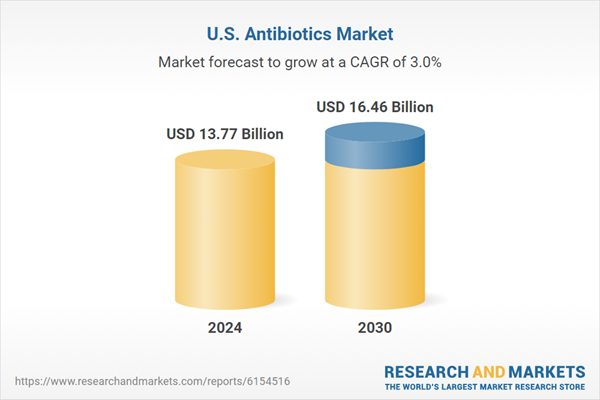The increasing prevalence of infections in the elderly and chronically ill significantly drives the U.S. antibiotics market. In 2024, over 60 million Americans were aged 65 or older, a demographic highly susceptible to infections like pneumonia, UTIs, and sepsis. In addition to that, the rising incidence of chronic conditions such as diabetes, cancer, and COPD compromises immune systems, leading to a greater need for antibiotics. According to CDC, nearly 60% of U.S. adults have at least one chronic disease, further expanding the patient base requiring antibiotic treatment.
The increasing number of surgical procedures and advanced medical interventions significantly contribute to the demand for antibiotics in the U.S. market. Procedures such as organ transplants, cancer treatments, and orthopedic surgeries often carry a high risk of post-operative infections, making preventive and therapeutic antibiotics essential. Hospitals and outpatient facilities depend on effective antibiotic regimens to reduce complications and improve patient recovery. As access to these procedures expands, antibiotics play an even more critical role in ensuring positive patient outcomes, solidifying their position as a vital part of modern medical care.
The U.S. antibiotics market is growing due to cutting-edge R&D, substantial healthcare spending, and a strong emphasis on innovation. The country leads globally in developing next-generation antibiotics to counter AMR, supported by policies such as the Generating Antibiotic Incentives Now (GAIN) Act of 2012, which provides incentives such as extended exclusivity periods. A notable instance is the collaboration between Merck and the National Institute of Allergy and Infectious Diseases (NIAID) in 2023 to develop novel antibiotics targeting multidrug-resistant bacteria.
U.S. Antibiotics Market Report Segmentation
This report forecasts revenue growth at country level as well as provides an analysis of the latest trends in each of the sub-segments from 2018 to 2030. For this study, the analyst has segmented the U.S. antibiotics market report on the basis of action mechanism, type, and drug class:Action Mechanism Outlook (Revenue, USD Million, 2018 - 2030)
- Cell Wall Synthesis Inhibitors
- Protein Synthesis Inhibitors
- DNA Synthesis Inhibitors
- RNA Synthesis Inhibitors
- Mycolic Acid Inhibitors
- Others
Type Outlook (Revenue, USD Million, 2018 - 2030)
- Branded Antibiotics
- Generic Anitbiotics
Drug Class Outlook (Revenue, USD Million, 2018 - 2030)
- Cephalosporins
- Penicillins
- Fluoroquinolones
- Macrolides
- Carbapenems
- Aminoglycosides
- Sulfonamides
- 7-ACA
- Other
Why should you buy this report?
- Comprehensive Market Analysis: Gain detailed insights into the global market across major regions and segments.
- Competitive Landscape: Explore the market presence of key players worldwide.
- Future Trends: Discover the pivotal trends and drivers shaping the future of the global market.
- Actionable Recommendations: Utilize insights to uncover new revenue streams and guide strategic business decisions.
This report addresses:
- Market intelligence to enable effective decision-making
- Market estimates and forecasts from 2018 to 2030
- Growth opportunities and trend analyses
- Segment and regional revenue forecasts for market assessment
- Competition strategy and market share analysis
- Product innovation listing for you to stay ahead of the curve
- COVID-19's impact and how to sustain in these fast-evolving markets
This product will be delivered within 2 business days.
Table of Contents
Companies Mentioned
- AbbeVie, Inc.
- Pfizer Inc.
- Novartis AG
- Merck & Co., Inc.
- Teva Pharmaceutical Industries Ltd.
Table Information
| Report Attribute | Details |
|---|---|
| No. of Pages | 100 |
| Published | July 2025 |
| Forecast Period | 2024 - 2030 |
| Estimated Market Value ( USD | $ 13.77 Billion |
| Forecasted Market Value ( USD | $ 16.46 Billion |
| Compound Annual Growth Rate | 3.0% |
| Regions Covered | United States |
| No. of Companies Mentioned | 5 |









